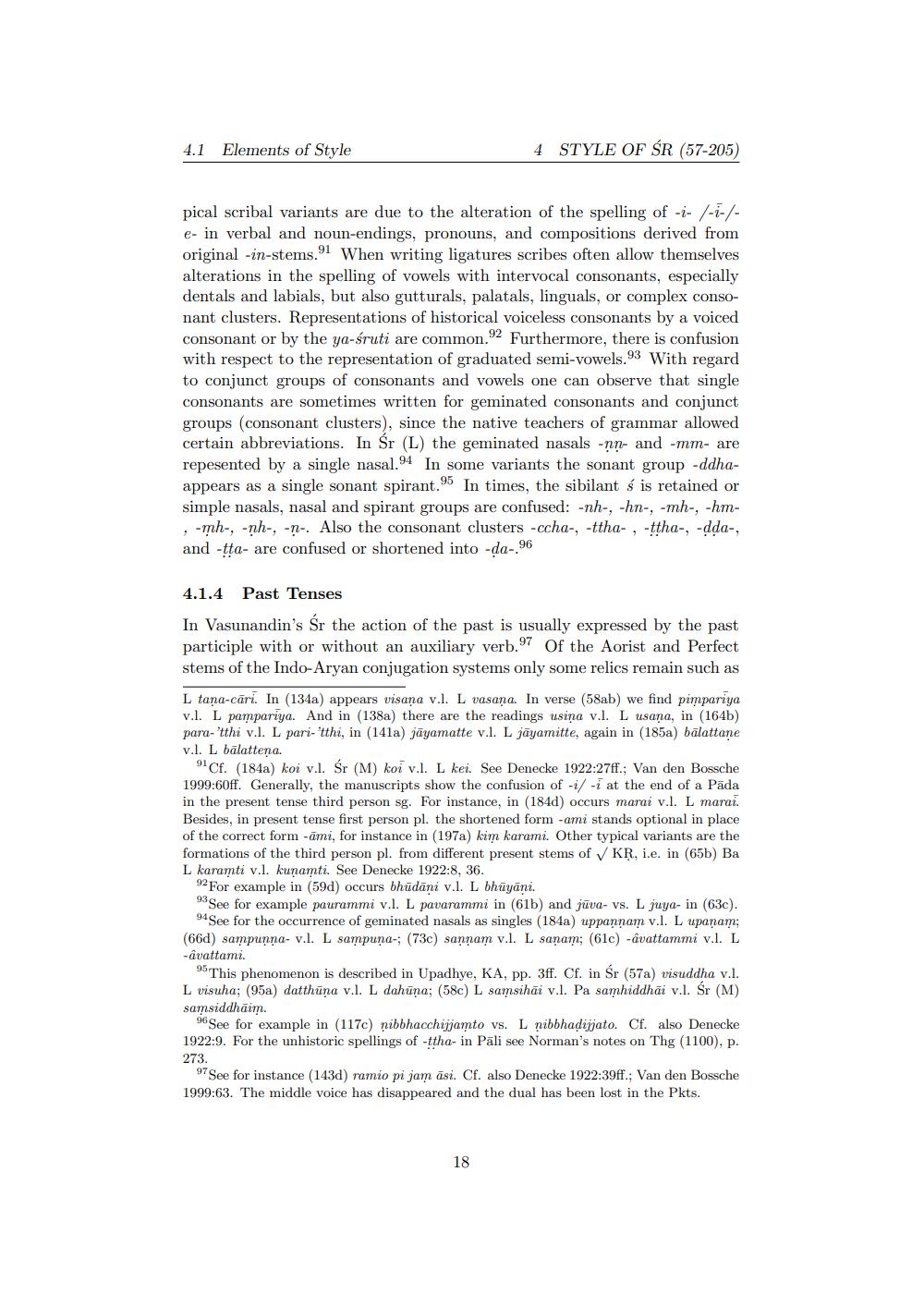________________
4.1 Elements of Style
4 STYLE OF ŚR (57-205)
pical scribal variants are due to the alteration of the spelling of - - /-1-/e- in verbal and noun-endings, pronouns, and compositions derived from original -in-stems. When writing ligatures scribes often allow themselves alterations in the spelling of vowels with intervocal consonants, especially dentals and labials, but also gutturals, palatals, linguals, or complex consonant clusters. Representations of historical voiceless consonants by a voiced consonant or by the ya-śruti are common.92 Furthermore, there is confusion with respect to the representation of graduated semi-vowels.93 With regard to conjunct groups of consonants and vowels one can observe that single consonants are sometimes written for geminated consonants and conjunct groups (consonant clusters), since the native teachers of grammar allowed certain abbreviations. In Śr (L) the geminated nasals -nn- and -mm- are repesented by a single nasal.94 In some variants the sonant group -ddhaappears as a single sonant spirant.95 In times, the sibilant s is retained or simple nasals, nasal and spirant groups are confused: -nh-, -hn-, -mh-, -hm; -mh-, -nh-, -n-. Also the consonant clusters -ccha-, -ttha- , -ttha-, -dda-, and-tta- are confused or shortened into -da-96
4.1.4 Past Tenses In Vasunandin's Sr the action of the past is usually expressed by the past participle with or without an auxiliary verb.97 Of the Aorist and Perfect stems of the Indo-Aryan conjugation systems only some relics remain such as
L tana-cāri. In (134a) appears visana v.l. L vasaņa. In verse (58ab) we find pimpariya v.l. L pampariya. And in (138a) there are the readings usina v.l. L usana, in (164) para-'tthi v.l. L pari-'tthi, in (141a) jāyamatte v.l. L jāyamitte, again in (185a) balattane v.l. L balattena.
Cf. (184a) koi v.l. Sr (M) koi v.l. L kei. See Denecke 1922:27ff.; Van den Bossche 1999:60ff. Generally, the manuscripts show the confusion of -i/ -1 at the end of a Pada in the present tense third person sg. For instance, in (1840) occurs marai v.l. L marai. Besides, in present tense first person pl. the shortened form -ami stands optional in place of the correct form -āmi, for instance in (1972) kim karami. Other typical variants are the formations of the third person pl. from different present stems of KR, i.e. in 65b) Ba L karamti v.l. kunamti. See Denecke 1922:8, 36.
92 For example in (592) occurs bhūdāni v.l. L bhūyani. 9 See for example paurammi v.l. L pavarammi in (61b) and jūva- vs. L juya- in (63c).
94 See for the occurrence of geminated nasals as singles (184a) uppannam v.l. L upanam; (660) sampunna- v.l. L sampuna-; (73c) sannam v.l. L sanam; (61c) -avattammi v.l. L -avattami.
95 This phenomenon is described in Upadhye, KA, pp. 3ff. Cf. in Śr (57a) visuddha v.l. L visuha; (95a) datthūņa v.l. L dahuna; (58c) L samsihāi v.l. Pa samhiddhāi v.l. Śr (M) samsiddhāim.
96 See for example in (117c) nibbhacchijjamto vs. L nibbhadijato. Cf. also Denecke 1922:9. For the unhistoric spellings of -ttha- in Pāli see Norman's notes on Thg (1100), p. 273.
97 See for instance (143d) ramio pi jam āsi. Cf. also Denecke 1922:39ff.; Van den Bossche 1999:63. The middle voice has disappeared and the dual has been lost in the Pkts.




